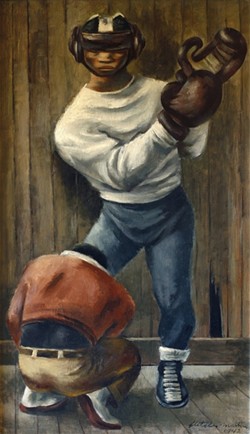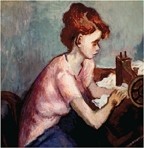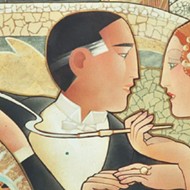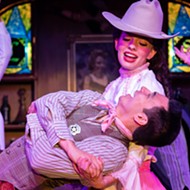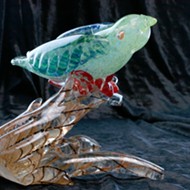Art collecting: a love story
The SLOMA exhibit 'American Scene' reveals a lifelong passion for lesser-known genre of art
By Anna Weltner[
{
"name": "Promo Temp Targeted",
"id": "PromoTempTargeted",
"class": "inlineCenter",
"insertPoint": "4",
"component": "15511697",
"requiredCountToDisplay": "0"
},
{
"name": "Ad - Medium Rectangle CC01 - 300x250 - Inline Content",
"class": "inlineCenter",
"insertPoint": "8",
"component": "15582119",
"requiredCountToDisplay": "12"
},{
"name": "Ad - Medium Rectangle LC01 - 300x250 - Inline Content",
"class": "inlineCenter",
"insertPoint": "18",
"component": "15582122",
"requiredCountToDisplay": "22"
},{
"name": "Ad - Medium Rectangle 9 - 300x250 - Inline Content",
"class": "inlineCenter",
"insertPoint": "28",
"component": "15582121",
"requiredCountToDisplay": "32"
}]
To really take in the exhibit “American Scene: The Arthur and Marilynn Rosenberg Collection” is to receive an education in a long undervalued area of art history.
Curated by Ruta Saliklis and hanging through March 31 at the San Luis Obispo Museum of Art, “American Scene” represents decades of thoughtful collection by the Rosenbergs, a local couple who discovered their passion for the genre known as American Scene painting while living in New York City in the 1980s. The artists associated with this loosely defined school of art were generally oriented around New York in the ’30s and ’40s, and are identified by their working-class subjects: blank-faced commuters on the subway; seamstresses and secretaries; immigrants and minorities. Many of the artists worked with (or were heavily influenced by) the Mexican muralists, such as Diego Rivera and David Alfaro Siqueiros. Most also studied and created under the auspices of the Works Progress Administration (WPA), the New Deal agency that provided jobs to a great many unemployed workers, including artists, writers, and musicians, with a goal of getting the American economy back on track.
As an exhibit, “American Scene” is comprehensive, thoughtful, and dense—though not to the point of overwhelming the eye. Rather, its density is in the sheer amount of looking and thinking that can be done in a relatively small space. Most of these paintings and drawings aren’t very big, yet their connection to one another, and to the bigger historical context to which they belong, warrants a level of contemplation disproportionate to their physical size. But there’s still another history present in “American Scene,” and it’s that of the collectors themselves.
The couple’s first encounter with the American Scene painters they would come to refer to as “our artists” is described in Arthur Rosenberg’s introductory essay “Charting a Course for Collecting Art.” He recalls his joy at the chance to view many works by artists of the Art Students League while he was hanging out at a gallery in Long Island, where art collectors gathered for informal conversation. Many of these pieces would later end up in major museums, he writes, but back then, amazingly, the owner simply kept them in a back room: “One of the paintings she brought out from the back storage bin had a hefty layer of dust. Yet despite the dust, the painting reached out to us, and it was almost like love at first sight.”
The piece was an oil painting by Fletcher Martin called Black King, which depicted an African-American boxer suiting up for a fight: As another man crouches at his feet—perhaps a trainer, lacing his shoes—the boxer pounds his gloved fist into an open palm in a gesture of heated anticipation. The work, one of the focal points of the SLOMA exhibit, marked the beginning of the Rosenbergs’ love affair with the American Scene, and the start of their self-mandated education in appreciating and collecting art. And while the couple had previously been content to buy prints and lithographs of works by artists they admired, here was a genre so undervalued that, until the art world caught up with them, they could afford to purchase originals.
But why were these paintings so cheap?
The artists of the American Scene were prolific, successful, and widely exhibited in their day, explained curator Saliklis, but were tossed aside when Abstract Expressionism and European Modernism came into vogue. Suddenly, next to the likes of, say, Wassily Kandinsky, the social realism of painters like Fletcher Martin was looking rather old-fashioned.
Worse still, by the ’50s, the American Scene people were starting to look like a bunch of commies. With their depictions of common workers, immigrants, and of general realties of life in New York City, painters of the genre came under suspicion for their seemingly leftist or anti-capitalist views. Instead of hanging in New York City’s important galleries, their works were instead relegated to such venues as the Marxist Library. (In fact, the Rosenbergs found Nicolai Cikovsky’s rather innocuous looking Park Fountain at a sale to benefit the Reference Center for Marxist Studies in New York City. A printed label next to the piece suggests the statue in the painting might be of Lenin or Stalin, but it’s honestly impossible to tell.)
Today, the American Scene has been rediscovered by many major museums. Works by artists in the Rosenbergs’ collection have now been acquired by the likes of the Whitney Museum and the New York MoMA. Moses Soyer’s 1942 painting Girl with a Sewing Machine, which hangs in the SLOMA exhibit, is in fact the study for a much larger work in the Metropolitan Museum of Art’s permanent collection.
The artists exhibited in “American Scene” are unified in their subject matter and their rejection of Modernist styles. Otherwise, they vary widely from one to another, ranging from the loose, sketchy lines of Byron Brown’s watercolors to the more realistic portraiture of Jerry Farnsworth, whose Manuel gazes with raised eyebrows at the viewer, as if caught off guard. German-born Karl Zerbe’s painting Herbstgarten was among those to be labeled “degenerate art” and destroyed by the Nazis in 1937; his mixed-media piece Circus Performer was created following his move to the United States the same year.
After Martin’s Black King won their hearts, the Rosenbergs began their collecting hobby in earnest, reading everything they could about the movement—if that’s what it was—and its key players. On their to-buy list were Cikovsky, Marion Greenwood, Bernard Kofiol, Sol Wilson, and of course, Martin. (But not just anything by Martin, Arthur explained in a phone interview. The painter was married four times, he said, and painted differently during each of his marriages.
“He got very frivolous with the last wife,” the collector added, a note of disappointment in his voice.
In their collection of Martin’s work, the couple considered only the artist’s paintings of athletes—his “sports era”—to be his worthwhile efforts.)
As Marilynn and he went from art newbies to informed collectors, Arthur says, they began to feel comfortable trusting their own instincts when it came to the once-intimidating activity of asserting an opinion: deciding if a work was good, and why. She possessed the research savvy, he the aesthetic eye. Anything they acquired had to stand the test of both.
The more Arthur and Marilynn devoted themselves to the search for the next great painting, the more their passion shaped their life choices. The couple bought their Arroyo Grande home partially on the basis of its good lighting, expansive walls, and adequate viewing space, Arthur says, and used only minimal decoration so as not to overwhelm the paintings.
Of course, with the majority of their cherished collection hanging in the “American Scene” exhibit, the Rosenbergs’ place is a little lonelier these days.
I asked Arthur how it feels to be without the paintings.
“Empty,” he said.
Arts Editor Anna Weltner is full of words. Contact her at [email protected].

